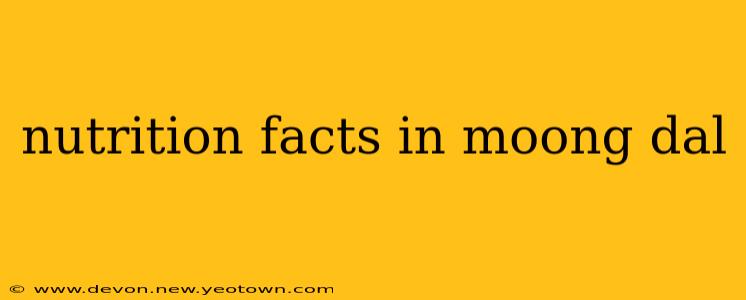Moong dal, also known as mung beans or green gram, isn't just a staple in many cuisines; it's a nutritional powerhouse packed with essential vitamins, minerals, and beneficial compounds. This humble legume has quietly earned its place as a superfood, offering a wealth of health benefits. Let's delve into the fascinating world of moong dal's nutritional profile and uncover why it deserves a prominent spot in your diet.
What are the key nutritional benefits of moong dal?
Moong dal boasts an impressive nutritional profile. Imagine a food brimming with protein, fiber, essential vitamins, and minerals – that’s moong dal in a nutshell. Its richness in protein makes it an excellent choice for vegetarians and vegans, providing the building blocks for muscle growth and repair. The high fiber content aids digestion, promotes satiety (keeping you feeling full longer), and contributes to healthy gut flora. It's also a fantastic source of folate, crucial for cell growth and development, especially during pregnancy. Iron, another vital component, supports healthy blood production, combating anemia. Beyond this, moong dal contains various antioxidants that fight free radicals, protecting your cells from damage.
How many calories are in a serving of moong dal?
The calorie count in moong dal varies depending on the serving size and preparation method. A typical 100-gram serving of cooked moong dal contains approximately 120-130 calories. This relatively low calorie count, coupled with its high nutrient density, makes it a smart choice for weight management. Remember, adding oils or fats during preparation will increase the overall calorie count.
Is moong dal good for weight loss?
Absolutely! Moong dal's high fiber and protein content plays a crucial role in weight management. The fiber creates a feeling of fullness, reducing overall calorie intake, while the protein contributes to muscle mass, boosting metabolism. However, remember that weight loss is a holistic process involving diet and exercise. Moong dal can be a valuable tool, but it’s not a magic bullet.
What are the different types of moong dal available?
You'll find moong dal in a few different forms: whole, split, and de-husked (also known as "dhuli"). Whole moong dal retains its skin, offering slightly more fiber. Split moong dal, with the outer skin removed, cooks faster and has a smoother texture. De-husked moong dal is even more readily digestible. The choice depends on personal preference and the desired cooking time.
What are the potential side effects of consuming moong dal?
While generally safe, excessive consumption of moong dal may cause digestive discomfort in some individuals due to its high fiber content. It's also important to note that individuals with specific allergies or sensitivities to legumes should exercise caution. Start with small portions to assess your tolerance.
How can I incorporate moong dal into my daily diet?
The versatility of moong dal is remarkable! It can be incorporated into a wide array of dishes. You can enjoy it as a simple dal (lentil soup), add it to salads for extra protein and texture, or use it to make delicious pancakes or cheela. Its mild flavor makes it compatible with numerous spices and herbs, opening up a world of culinary possibilities. Experiment and find the ways you enjoy it most!
In conclusion, moong dal is a nutritional superstar deserving of a prominent place in your diet. Its impressive nutrient profile, versatility, and numerous health benefits make it an excellent choice for maintaining good health and well-being. So, embrace the power of this humble legume and unlock its incredible nutritional potential!

